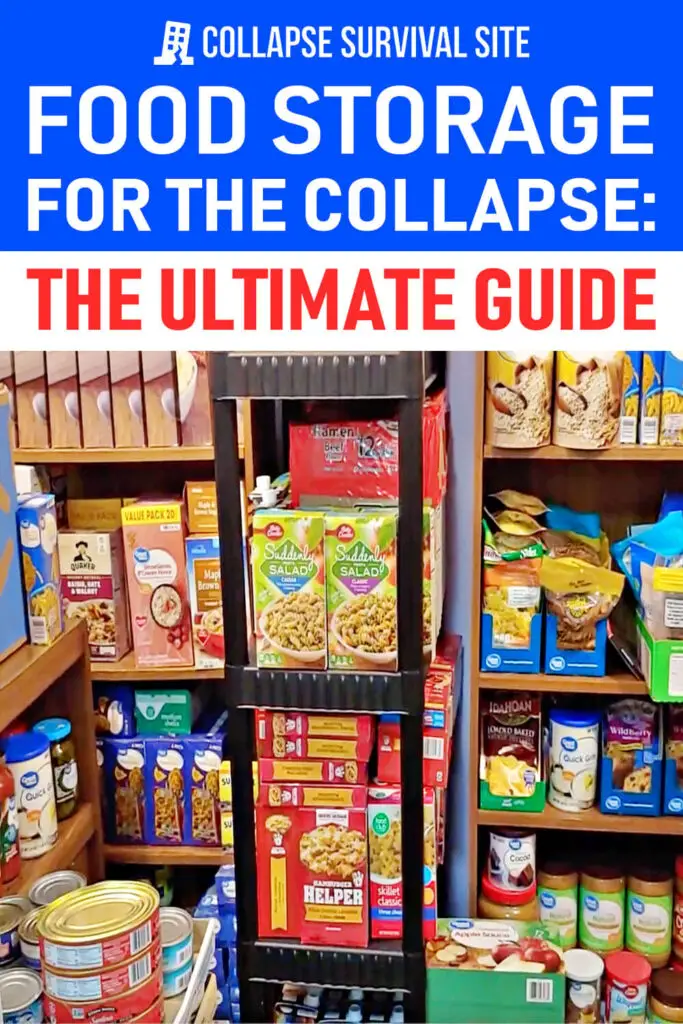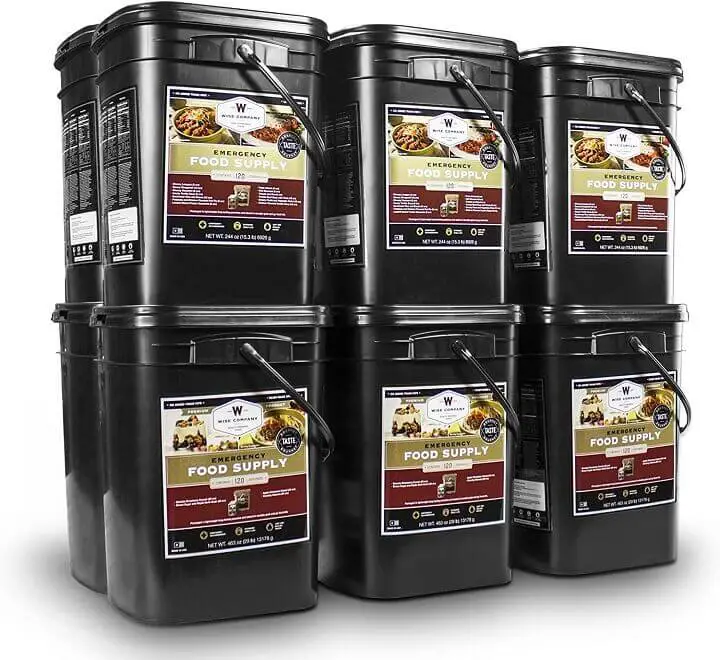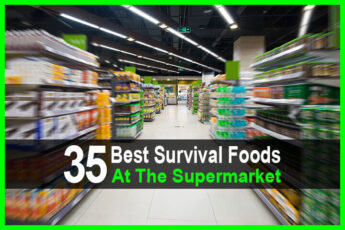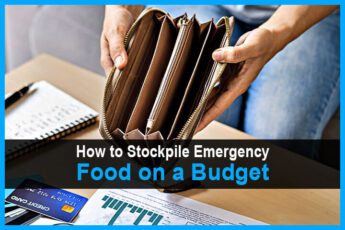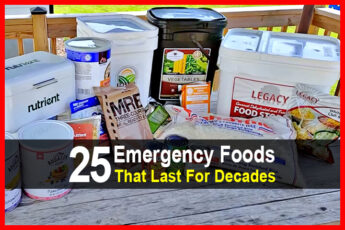Estimated reading time: 20 minutes
Of all the things a civilization needs to maintain itself, food is probably the most crucial. As long as people have enough food to avoid starving, they will continue with their daily routines. And in a major disaster, they'll go to great lengths to help their neighbors.
But once the food is gone, it becomes every man for himself. People who were once kind and generous become selfish and dangerous, doing whatever it takes to feed themselves and their families. Because without food, nothing else matters.
We know this, and we also know that it's only a matter of time before there's not enough food to go around. Floods and heatwaves are already destroying crops, and climate change is going to make them exponentially worse in the coming years.
Megadroughts are forcing farmers to pump groundwater, but even the aquifers are drying up. Meanwhile, the world's supply of fossil fuels continues to shrink, making fertilizer prices more and more expensive. (Without ammonia derived from natural gas, half the world would starve.)
And even if we didn't have those problems, we'd still have the problems of topsoil erosion, the mass death of pollinators, livestock pandemics, and the collapse of the world's fisheries. As the global population grows and our exploitation of the planet continues, these problems will only get worse.
Want to save this post for later? Click Here to Pin It On Pinterest!
Why You Need Food Storage
This is why food storage should be a top priority when preparing for the collapse. You don't have to stockpile enough food to last the rest of your life, but you want at least a year's supply. The hope is that after a year, communities will develop barter economies where locals can trade home-grown produce, meat, and dairy with one another.
If nothing else, having a stockpile of food will allow you to get through temporary disasters and supply chain disruptions without going hungry. But what kinds of food should you store, and how much? In this article, we're going to lay out a one-year food storage plan.
Food Storage 101
We’re going to explore some of the best practices for assembling a 1-year stockpile of food. We’re going to do it for one person, so if you're storing food for more than one person, you’ll need to multiply the amounts by the number of people in your group or family.
Let’s Start with Calories
Avoiding starvation and maintaining good health through nutrition starts with calories. On average, a healthy active adult needs at least 2,600 calories a day to maintain their body weight and physical health. Any strenuous activity can increase the number of calories needed, but as a benchmark, we’re going to stick with 2,600 calories a day.
Here’s where things get a bit daunting. If you multiply 2,600 calories a day by the 365 days in a year, the total is 949,000 calories for a 1-year supply of food for one active adult. If that sounds like a lot, it is. Here’s a chart that could help you do some additional calculations for children and people of various ages and activity levels:
| GENDER | AGE | SEDENTARY | MODERATELY ACTIVE | ACTIVE |
|---|---|---|---|---|
| CHILD | 2-3 | 1000 | 1000-1400 | 1000-1400 |
| FEMALE | 4-8 | 1200 | 1400-1600 | 1400-1800 |
| 9-13 | 1600 | 1600-2000 | 1800-2200 | |
| 14-18 | 1800 | 2000 | 2400 | |
| 19-30 | 2000 | 2000-2200 | 2400 | |
| 31-50 | 1800 | 2000 | 2200 | |
| 51+ | 1600 | 1800 | 2000-2200 | |
| MALE | 4-8 | 1400 | 1400-1600 | 1600-2000 |
| 9-13 | 1800 | 1800-2200 | 2000-2600 | |
| 14-18 | 2200 | 2400-2800 | 2800-3200 | |
| 19-30 | 2400 | 2600-2800 | 3000 | |
| 31-50 | 2200 | 2400-2600 | 2800-3000 | |
| 51+ | 2000 | 2200-2400 | 2400-2800 |
Balancing Nutrition Across Foods in Storage
There are essentially three types of calories: calories from carbohydrates, calories from fat, and calories from protein.
Calories from carbohydrates are the most important for energy, calories from fat are necessary for brain health and for maintaining body heat, and calories from protein are important for muscle and heart health. These three types of calories are called macronutrients.
Beyond macronutrients, you need a wide range of vitamins and minerals, which are critical for our immune systems and overall health. This is important to understand because a lot of prepackaged survival foods don't have a lot of important nutrients. Don't just buy what looks tasty; buy what will keep you healthy.
Water as a Fundamental Ingredient
Many food preparation steps require the use of water for cooking. But there’s a lot more to water than cooking. We can’t survive 3 days without water. Food is important, but water is critical. That means you’ll need to give some thought and consideration to emergency water storage along with water collection and purification.
Assessing Packaging and Repackaging Foods for Long-term Storage
Unique packaging specially designed for long-term food storage is ideal, and it usually appears as hard, plastic containers or sealed Mylar bags. They are usually vacuum sealed and sometimes have oxygen absorbers placed inside to enhance shelf-life.
One thing to keep in mind when buying emergency food is the packaging. Foods that come in a can or a hard plastic package will last longer than food in a cardboard box or thin plastic bag.
That’s when you may need to consider repackaging some foods in Mylar bags that you can buy online and seal yourself. Make sure you mark the contents, weight, and date on any food you repackage.
You may also want to add oxygen absorbers if the food is particularly sensitive to moisture. For example, foods like rice, pasta, and grains in general.
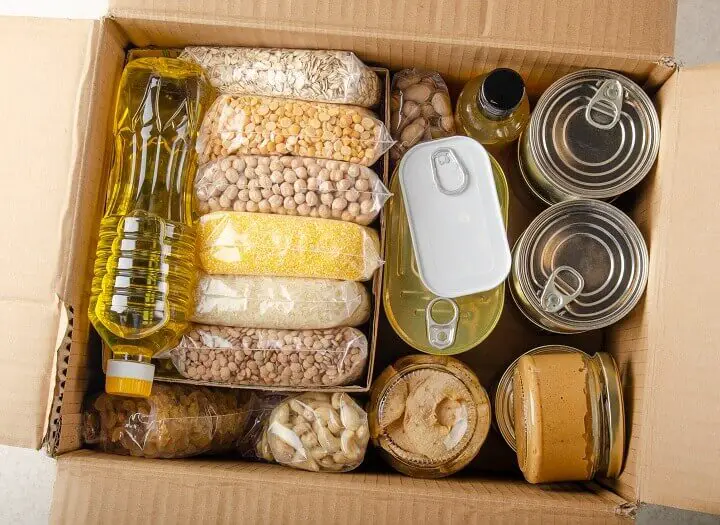
Managing and Rotating Foods Based on Shelf-life
This is the ultimate challenge for anyone storing food for a long time. Some foods like honey have shelf-lives measured in decades or more. Others, like vegetable oils, can turn rancid after a year. Buying foods with very long shelf-lives is one solution, but it leaves out a lot of the everyday foods and flavors we’re accustomed to.
One critical thing to keep in mind is that best-by and expiration dates are not hard and fast rules with many packaged goods. Those dates may matter for refrigerated foods, but foods that are well-packaged will remain safe and retain much of their nutritional value long after the expiration date.
The best approach is a strategy we’ll cover with at least 2 different pantries in your home. One is for everyday foods, and the other is for long-term foods with a dedicated shelf for things like vegetable oil which needs to be rotated out and into the everyday pantry.
It gets to a fundamental food storage maxim: “Eat what you store, and store what you eat.” That can be harder to do than it sounds, but if you pay attention to all of your food storage, you can manage a proper rotation of foods that won’t last as long as others.
Managing Costs as You Assemble a Year’s Supply of Food
949,000 calories sounds expensive, and it will be, depending on your budget. That cost will grow as you store food for more members of your family. If you have the money, you can go all-in and just fill your pantries after a few weeks of shopping.
If you’re like most of us, you’ll need to slowly grow your food storage. This has some advantages. It will allow you to shop the sales, search discount stores like Costco or Sam’s Club, and comparison shop on the Internet.
There are various approaches to growing your food storage. You could spend an extra 10% on emergency food every time you go shopping, or you could grow, forage, hunt, fish, and preserve the foods you acquire. You’ll need to master various food-preservation techniques, but it will be worth it.
Types of Storage
A common approach used by many people assembling long-term food storage is a “two pantry system.”
One pantry, sometimes called the “front pantry,” is for your everyday foods. You can certainly stock it up to the max, but this is where your ability to rotate foods is easiest. It’s usually located in or near the kitchen.
The second pantry is referred to as the “back pantry.” It can be on the same floor as the front pantry, but ideally it would be in an area of the house with a consistently low temperature and low humidity. It should also have enough space and shelving to hold and display your assembled foods.
One of the components of a back pantry should be the active or “short shelf.” This is the area where foods with shorter shelf-lives are stored. Even something like olive oil, which can have a shelf-life of up to 2 years, can have problems.
The dilemma is that we never know when disaster may strike. It could be 5 years, 10 years, or longer. As we wait for any level of collapse, we can sometimes forget about a lot of that food in the basement. Don’t forget it, and keep it up to date as much as possible.
Regardless of the type of pantry, very few pantries are refrigerated or frozen. In a time when you’re depending on food in storage to survive, there’s a good possibility that the grid will be down.
What’s critical is that the space maintains a temperature range of 40 to 70 degrees Fahrenheit. That’s one of the reasons why basements are often the preferred location for long-term food storage, as long as it's not too humid.
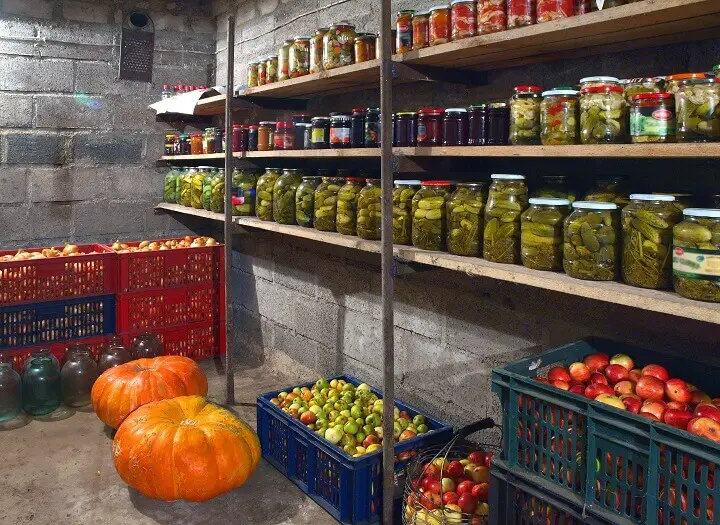
12 Basic Food Categories to Store
There are 12 broad categories of food that usually comprise a long-term food storage pantry. Within each category are specific food types, but as a general rule, these categories define a good combination of foods to maintain weight and overall health as a daily diet.
We’ll follow this section with a line-item checklist for each of these categories:
1. Beans & Legumes
Beans and peas (sometimes referred to as legumes) are the protein champions. For vegans, they represent a primary source of protein including complex amino acids. A distinct benefit is that they can be stored in bulk as dried beans and peas, providing significant nutrient density and good survivability in terms of shelf-life.
2. Rice
Rice is a significant source of calories from carbohydrates and provides energy to any diet. You should store both white and brown rice, but remember that brown rice has a shorter shelf life than white rice. Brown rice has better nutrient density, but both provide a good amount of calories and are stored as hard, dry grains.
3. Vegetables
Vegetables are one of the champs when it comes to vitamins and minerals. Generally, they provide fewer calories than other foods, but their overall nutrient density and fiber make them one of the healthiest additions to any diet.
Vegetables can be stored a variety of ways from canned to freeze dried, dehydrated, and some can even be stored raw in a root cellar following any harvest.
4. Fruits & Nuts
Fruits and nuts are another champ when it comes to nutrition. Fruits are particularly rich in vitamin C, and nuts provide significant calories from fats and are an excellent source of protein.
5. Dairy
Dairy products include items made from milk and eggs. They are a critical source of calcium and vitamin D for overall bone health. Both are a challenge in a non-refrigerated or unfrozen environment, but there are many options for dairy products in a powdered or canned form.
This includes not only milk but cheese powders, butter powders, and powdered eggs.
6. Grains
Grains define a broad category of foods, particularly wheat-based products, but they also include rolled oats (oatmeal), flours, and other cereal products.
Flours can be stored in hermetically sealed plastic or Mylar packages, but whole grains or wheat berries provide a longer-shelf life than flour, although whole grains need to be ground into flour with a flour mill for many recipes
7. Meats & TVP
It’s unusual to think of meats in a non-refrigerated or unfrozen environment, but we eat them all the time whenever we buy a can of chili, beef stew, or chicken soup.
Canned meats have been common in food stockpiles for a long time, going back to meats like SPAM, but even basic meat ingredients like cooked and canned ground beef are a good option. You can also preserve your own meats through pressure canning
Another meat possibility is textured vegetable proteins or TVP’s. They are usually in a shredded and dry form and are typically packaged in hermetically sealed #10 cans.
8. Seafood
This is another food you don’t expect to find outside of a refrigerator or freezer, but once again it’s quite common. Canning is the most popular packaging option for tuna, sardines, anchovies, oysters, herring, and even salmon.
9. Prepared Foods
These are usually canned foods that come as an already-prepared meal like beef stew, spaghetti sauces, chicken ala king, and others. They tend to be a bit more expensive, but they can be a valuable food option during particularly stressful times when there’s simply no time for food preparation.
10. Pastas
Pastas are another good source of calories from carbohydrates and also present good shelf stability when packaged in Mylar bags or hermetically sealed plastic buckets. A simple combination of macaroni noodles and cheese powder makes a perfect mac and cheese as the ultimate kid comfort food.
11. Cooking & spices
Anyone with good cooking and baking skills can significantly reduce the cost and types of foods in storage. The ability to bake breads, biscuits, pies plus combine varied ingredients to make nutritious meals from staples rather than more expensive prepared foods is an added advantage.
12. Beverages
Water tops the list, but the ability to add flavor, vitamins, and even antioxidants to water is well worth a place on the shelf. Powdered drink mixes define most beverage options in a long-term pantry.
Planning a One-Year Food Storage Checklist
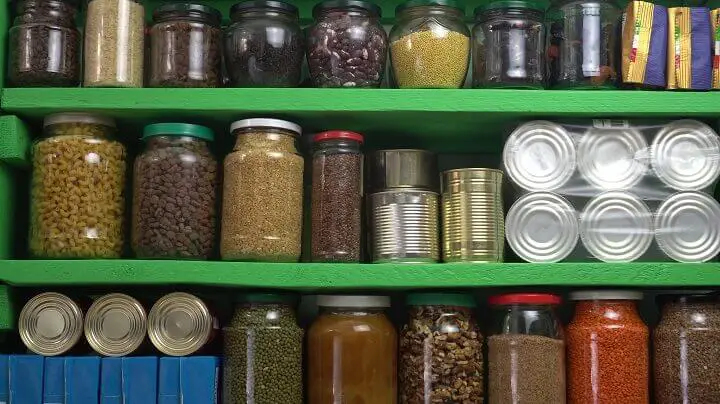
This checklist is designed for 1 adult assuming an average calorie intake of 2,600 calories a day and sufficient nutrients to maintain body weight and overall health for one year. You’ll need to add additional quantities depending on the age and number of people in your group.
Activity levels are also worth considering, although you may be able to supplement your food storage through the preservation or consumption of foods from gardening, hunting, fishing or wild foraging.
Each item on the chart is defined by the following characteristics:
Food Type and Items by Categories
These are the most common food items that define the category. You can vary this to any degree you like. Some people grew up with different types of foods or are used to cuisines from different cultures. Feel free to improvise, but keep an eye on calories and nutrition as you substitute.
Quantity Recommended Per Item in Dry or Wet Measures
This is how much you need in ounces, pounds, gallons, or other measures to provide the calories for this type of food.
Shelf-life Assuming Proper Packaging and Storage for Each Type of Food
Shelf-life varies and can affect how you rotate items, and sometimes it makes sense to store items with a similar shelf-life in the same location, even though they may be totally different types of foods.
Calories
This is one of the most critical measures when estimating how much food you need for 1 year.
General Nutrition (Proteins, Vitamins, Minerals, Other Nutrients)
A snapshot of the key nutrients for each food type.
Best Packaging for Each Type of Food
Some foods can be stored with their original packaging and others are best repackaged. This will give you some insight on how best to package each individual food item before storing. One good solution is large rigid, plastic containers with screw on lids.
Food Storage Checklist
| FOOD TYPE | QUANTITY | SHELF LIFE | CALORIES | NUTRITION | BEST PACKAGE |
|---|---|---|---|---|---|
| BEANS | |||||
| Black beans | 25 LBS. | 10 yrs. | 28,000 | Protein & fiber | Mylar bag |
| Black-eyed peas | 4 LBS. | 10 yrs. | 2,100 | Protein & fiber | Mylar bag |
| Garbanzo beans | 25 LBS. | 10 yrs. | 41,725 | Protein & fiber | Mylar bag |
| Green split peas | 4 LBS. | 10 yrs. | 6,200 | Protein & Potassium | Mylar bag |
| Kidney beans | 25 LBS. | 10 yrs. | 37,775 | Protein & fiber | Mylar bag |
| Lentils | 10 LBS. | 10 yrs. | 5,160 | Potassium & Iron | Mylar bag |
| Lima beans | 20 LBS. | 10 yrs. | 10,080 | Protein & fiber | Mylar bag |
| Pinto beans | 10 LBS. | 10 yrs. | 10,000 | Protein & fiber | Mylar bag |
| GRAINS | |||||
| All-purpose flour | 20 LBS. | 10 yrs. | 33,000 | Carbs | Plastic pail |
| Bread flour | 50 LBS. | 5 yrs. | 81,850 | Carbs | Mylar bags |
| Farina | 8 LBS. | 5 yrs. | 13,320 | Carbs | Mylar bags |
| Rolled oats (oatmeal) | 10 LBS. | 8+ yrs. | 17,280 | Fiber | Plastic bucket |
| Wheat berries | 25 LBS. | 10+ yrs. | 38,775 | Protein | Mylar bags |
| Whole wheat flour | 50 LBS. | 10 yrs. | 76,900 | Carbs | Mylar bags |
| PASTA | |||||
| Elbow macaroni | 9 LBS. | 20 yrs. | 15,120 | Carbs | Plastic bucket |
| Rotini | 3 LBS. | 20 yrs. | 5,600 | Carbs | Plastic bucket |
| Spaghetti | 10 LBS. | 20 yrs. | 16,000 | Carbs | Mylar bags |
| RICE | |||||
| Brown rice | 24 LBS | 5 yrs. | 12,050 | carbs | Plastic pail |
| White rice | 50 Lbs | 10 yrs. | 29,550 | Carbs | Mylar bag |
| PREPARED FOODS | |||||
| Beef stew | 24 cans | 2 – 3 yrs. | 9,600 | Protein | Canned |
| Beef vegetable soup | 12 cans | 2 – 3 yrs. | 2,880 | Protein | Canned |
| Chili with beans | 16 cans | 2 – 3 yrs. | 12,480 | Protein | Canned |
| Corned beef hash | 12 cans | 2 – 3 yrs. | 4,560 | Protein | Canned |
| Spaghetti sauce with meat | 12 cans | 2 – 3 yrs. | 2,160 | Protein | Canned |
| Spam | 12 cans | 2 – 3 yrs. | 2,160 | Protein | Canned |
| Vienna sausages | 12 cans | 2 – 3 yrs. | 4,160 | Protein | Canned |
| FRUITS | |||||
| Assorted jams and jellies | 200 single servings | 2-5 yrs. | 7,000 | Vitamins minerals | Sealed plastic cups |
| Cashews | 25 LBS. | 2-5 yrs. | 62,700 | Protein | Mylar bags |
| Dried apples | 1 #10 can | 20 yrs. | 840 | Vitamins minerals | Canned |
| Dried apricots | 3 LBS. | 2-5 yrs. | 3,300 | Vitamins minerals | Plastic jar |
| Dried blueberries | 1 #10 can | 20 yrs. | 1,170 | Vitamins minerals | Canned |
| Dried cranberries | 6 LBS. | 20 yrs. | 2,560 | Vitamins minerals | Mylar bags |
| Dried mangos | 1 #10 can | 20 yrs. | 1,050 | Vitamins minerals | Canned |
| Dried raspberries | 1 #10 can | 20 yrs. | 880 | Vitamins minerals | Canned |
| Dried strawberries | 1 #10 can | 20 yrs. | 630 | Vitamins minerals | Canned |
| Fruit cocktail | 24 15oz. cans | 2-5 yrs. | 8,400 | Vitamins minerals | Canned |
| Mandarin oranges | 24 15oz. cans | 2-5 yrs. | 3,900 | Vitamins minerals | Canned |
| Peaches | 24 15oz. cans | 2-5 yrs. | 3,980 | Vitamins minerals | Canned |
| Peanut butter | 9 LBS. | 1 year | 24,000 | Protein | Plastic Bucket |
| Pears | 24 15oz. cans | 2-5 yrs. | 4,320 | Vitamins minerals | Canned |
| Raisins | 10 LBS. | 2-5 yrs. | 13,560 | Vitamins minerals | Mylar bags |
| Walnuts | 5 LBS. | 2-5 yrs. | 15,800 | Protein | Mylar bags |
| VEGETABLES | |||||
| Tomato sauce | 48 15 oz. cans | 2-5 yrs. | 7,000 | Vitamins minerals | Canned |
| Beets | 12 15 oz. cans | 2-5 yrs. | 1,630 | Vitamins minerals | Canned |
| Corn kernels | 24 15.25 oz cans | 2-5 yrs. | 8,800 | Vitamins minerals | Canned |
| Creamed corn | 12 14.75oz cans | 2-5 yrs. | 4,000 | Vitamins minerals | Canned |
| Dehydrated bell peppers | 3 LBS. | 20 yrs. | 4,270 | Vitamins minerals | Canned |
| Dehydrated carrots | 1 #10 can | 20 yrs. | 4,000 | Vitamins minerals | Canned |
| Dehydrated onions | 1 #10 can | 20 yrs. | 2,700 | Vitamins minerals | Canned |
| Dehydrated peas | 2 #10 cans | 20 yrs. | 3,160 | Vitamins minerals | Canned |
| Dehydrated potato slices | 6 LBS. | 20 yrs. | 8,500 | Vitamins minerals | Plastic bucket |
| Potato flakes | 3 #10 cans | 30 yrs. | 15,900 | Vitamins minerals | Canned |
| Stewed tomatoes | 48 14.5 oz. cans | 2-5 yrs. | 5,750 | Vitamins minerals | Canned |
| Whole tomatoes | 24 14.5 oz. cans | 2-5 yrs. | 3,500 | Vitamins minerals | Canned |
| DAIRY | |||||
| Dried milk powder | 20 LBS. | 20 yrs. | 37,300 | calcium | Plastic bucket |
| Dried butter powder | 4 LBS. | 20 yrs. | 7,100 | calcium | 2 #10 cans |
| Dried cheese powder | 6 LBS. | 20 yrs. | 5,160 | calcium | 2 #10 cans |
| Dried egg powder | 4 LBS. | 20 yrs. | 5,500 | Protein | 2 #10 cans |
| MEATS & TVP | |||||
| Bacon TVP | 1 LB. | 20 yrs. | 1,590 | Protein | Plastic bottle |
| Beef TVP | 4 LBS. | 20 yrs. | 8,000 | Protein | 3 #10 cans |
| Canned chicken | 6 LBS. | 2,520 | Protein | Canned | |
| Canned ground beef | 21 LBS. | 11,760 | Protein | Canned | |
| Chicken TVP | 4 LBS. | 20 yrs. | 7,380 | Protein | 3 #10 cans |
| Chili TVP | 4 LBS. | 20 yrs. | 5,780 | Protein | 1 #10 can |
| Dehydrated chicken | 1 LB. | 20 yrs. | 2,250 | Protein | 1 #10 can |
| Freeze dried ground beef | 1 LB. | 20 yrs. | 2,340 | Protein | 1 #10 can |
| Jerky | 10 LBS. | 18,600 | Protein | Mylar bags | |
| SEAFOOD | |||||
| Anchovies | 12 cans | 2 – 3 yrs. | 600 | Protein | Canned |
| Herring | 18 cans | 2 – 3 yrs. | 2,520 | Protein | Canned |
| Oysters | 10 cans | 2 – 3 yrs. | 700 | Protein | Canned |
| Salmon | 24 cans | 2 – 3 yrs. | 2,400 | Protein | Canned |
| Sardines | 36 cans | 2 – 3 yrs. | 7,200 | Protein | Canned |
| Tuna | 48 cans | 2 – 3 yrs. | 6,720 | Protein | Canned |
| COOKING & SPICES | |||||
| Apple cider vinegar | 3 gallons | 2 yrs. | 0 | Micro nutrients | Plastic bottle |
| Baking powder | 24 ozs. | 30+ yrs | 0 | N/A | Plastic jar |
| Baking soda | 72 ozs. | 30+ yrs | 0 | N/A | Plastic bottles |
| Black pepper | 1 LB. | 1 year | 1500 | N/A | Plastic jar |
| Canning & pickling salt | 8 LBS. | 100 yrs. | 0 | Sodium | Mylar bags |
| Chili seasoning mix | 1.5 LBS. | 3 yrs. | 2,000 | Sodium | Plastic bottle |
| Cinnamon | 1 LB. | 3 yrs. | 1,100 | Micro nutrients | Plastic jar |
| Coconut oil | 32 ozs. | 2 yrs. | 8,300 | Fats | Plastic jar |
| Corn starch | 1 LB. | 30+ yrs | 1,860 | N/A | Plastic bottle |
| Garlic powder | 1 LB. | 3 yrs. | 1,500 | Micro nutrients | Plastic jar |
| Imitation vanilla | 1 gallon | 1 year | 7700 | Carbs | Plastic jug |
| Kosher salt | 20 LBS. | 100 yrs. | 0 | Sodium | Mylar bags |
| Olive oil | 1 gallon | 2 yrs. | 30,200 | Fats | Plastic bottle |
| Onion powder | 1 LB. | 3 yrs. | 1,500 | Micro nutrients | Plastic jar |
| Oregano | 1 LB. | 3 yrs. | 1,100 | Micro nutrients | Mylar bag |
| Sage | 12 ozs. | 3 yrs. | 450 | Micro nutrients | Plastic bottle |
| Shortening | 48 ozs. | 2 yrs. | 12,500 | Fats | Mylar tin |
| Vegetable oil | 4 gallons | 1 year | 30,700 | Fats | Plastic bottle |
| White vinegar | 5 gallons | 100 yrs. | 5 | Micro nutrients | Plastic bottle |
| Yeast | 1 LB. | 2 yrs. | 0 | N/A | Mylar bags |
| SUGARS | |||||
| Brown sugar | 8 LBS. | 30+ yrs | 11,900 | Carbs | Plastic bucket |
| Honey | 12 gallons | 30+ yrs | 16,600 | Carbs | Plastic bucket |
| Syrup | 2 gallons | 30+ yrs | 7,000 | Carbs | Plastic bottle |
| White sugar | 10 LBS. | 30+ yrs | 35,000 | Carbs | Plastic bucket |
| CONDIMENTS | |||||
| BBQ Sauce | 1 gallon | 2 – 3 yrs. | 9,500 | Sodium vitamins | Plastic bottle |
| Hot sauce | 1 gallon | 5 yrs. | 0 | Sodium vitamins | Plastic bottle |
| Mustard, ketchup, mayo, relish | 400 packets | 2 – 3 yrs. | 400 | Sodium vitamins | Packets |
| Soy sauce | 1 gallon | 5 yrs. | 2,500 | Sodium vitamins | Plastic bottle |
| Teriyaki sauce | 64 ozs. | 5 yrs. | 2,800 | Sodium vitamins | Plastic bottle |
| Worcestershire sauce | 1 gallon | 5 yrs. | 0 | Sodium vitamins | Plastic bottle |
| BEVERAGES | |||||
| Chocolate drink powder | 2.5 LBS. | 3 yrs. | 4,250 | Carbs | Plastic bottle |
| Coffee creamer powder | 4 LBS. | 3 yrs. | 10,000 | Carbs | Plastic can |
| Electrolyte powder | 36 packets | 3 yrs. | 1,440 | Micro nutrients | Mylar packet |
| Fortified orange drink powder | 3.5 LBS. | 3 yrs. | 13,160 | Vitamins | Mylar can |
| Instant coffee | 1,000 packets | 20 yrs. | 0 | N/A | Mylar packets |
| Lemonade powder | 10 LBS. | 3 yrs. | 8,100 | Vitamins | Mylar can |
| Tea varieties | 120 tea bags | 1 year | 0 | Micro nutrients | Mylar bags |
| Water | 60 gallons | 100 yrs. | 0 | Water | Stacked 5-gallon cans |
Total Calories: 1,044,050
Some Thoughts on This Checklist
We’ve exceeded our goal of 949,000 calories with a total of 1,044,050 calories. That’s actually a bit short. That’s because some items like sugar, spices, and other foods that fall in the category of ingredients may not be totally used up in the course of a year. As a result, leftovers add to the total.
The key is to make sure you consume at least 949,000 calories over the course of a year to maintain a daily intake of at least 2,600 calories. Hopefully, you can add to any deficit from gardening and wild foraging or hunting and fishing. If not, you may need to add a bit more to your storage.
Managing Cost for Food in Storage
As you look at the list and consider some of the quantities and costs, it could be hard to know where to start and how to afford it. Here are few points to ponder.
DIY Food Preservation
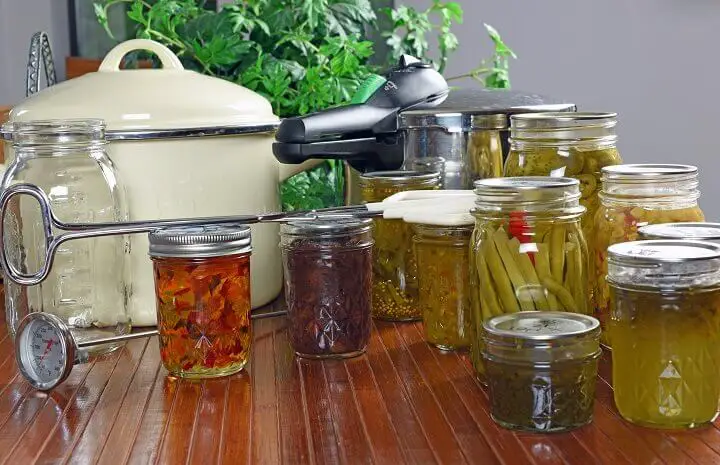
Buy it or do-it-yourself. Preserving your own foods can significantly reduce the cost of your food storage. Some preservation techniques are simple, some more complex. Here are the standard approaches:
- Canning in a hot water bath. This is involves canning foods and then boiling the canned foods in a water bath for 15 to 20 minutes. These types of food are usually canned in vinegar or are foods that are naturally high in acids with a low pH. The shelf life is usually measured in only a year or more. Foods that are best hot-water canned include vegetables and fruits or other foods that either have a high acidic level on the pH scale or are canned in acids like vinegar.
- High Pressure Canning in a pressure canner usually preserves foods for a much longer period—up to 5 years. It is commonly used for meats and other foods with a high pH or high alkalinity that are more likely to encourage bacterial growth. The temperatures from high pressure canning effectively kill all bacteria.
- Dehydration is an ancient technique and involves removing water or moisture from foods that often lead to bacterial and fungal growth. Vegetables, fruits and even meats and seafood can be dehydrated, although all will require some degree of rehydration before eating.
- Freeze-drying is a contemporary food preservation technique that can result in a 30-year shelf-life if done properly across a range of foods. Freeze-fried foods also require rehydration if not incorporated into a recipe with some liquids.
- Salt-curing is another ancient technique that essentially desiccates food by removing all moisture. It also requires rehydration, and most salt-cured foods require a soaking period to remove excess salt. Meats and fish are sometimes salt-cured.
- Smoking is a pioneer technique, and while it can extend the shelf-life of meat and seafood, it results in a shelf-life that is difficult to track or trust in the long-term.
What’s critical is that you take the time to do some due diligence on any food preservation technique that you try to do on your own, and be sure you understand the strengths and limitations of each one.
Bulk Buying
What’s good about buying a lot of anything is that you can usually get a discount when buying in bulk. Rather than buying a pound or two of black beans on each shopping trip for your food storage, consider buying a 20-pound bag of black beans and you’ll no doubt save some money.
Discount Food Retailers
It’s not just about commodities like beans and rice. Discount retailers like Costco and Sam’s Club sell large quantities of products in cans and boxes for a discount. The key is to shop around and see what they sell in bulk that can save you money.
Shopping the Sales
Every now and then, a grocery store chain will engage in some significant discounting on certain items as a loss leader. If you see a circular in the mail or an online promotion for significant discounts at a grocery store, make the trip and only buy the sale items for your food storage, or limit your other purchases.
Watch for Clearance Tags
Many stores will flag a deep discount on discontinued items with a red price tag. If you spot one of those tags on any shopping trip, stop and think about whether it satisfies something on your checklist and buy as many as you think you can afford.
Check the expiration dates, but most times they will still be active, and even then you can eat most packaged foods after the printed expiration.
Online
The great thing about shopping online is that you can comparison shop without a lot of time and effort. Amazon is an obvious destination but many food processors have their own websites and sell direct.
Online resources are also an excellent way to find specialized foods processed and designed for long-term food storage. These foods are often sold in #10 cans or 5-gallon plastic buckets. They are rarely cheap, but they do offer products at a discount from time to time.
The obvious benefit of buying a long-term food product with a 20 or 30 year shelf life is that it’s a one-and-done proposition. You buy it, store it, and don’t have to fuss around too much with rotation and worrying about shelf-life.
Unique Dietary Needs
It’s easy to assume the law of averages, but most people are unique and some have unique dietary needs. Here are some things to think about when storing food for a year for a family or group:
Kids will endure significant stress during any time of uncertainty, and foods offer them some degree of comfort. Kids also need good and well-rounded nutrition related to proteins, calcium, vitamins, and minerals as they grow.
Consider the following:
- Fruit snacks or fruit gummies as a candy source.
- Crackers or some kind of chips.
- A kid’s chewable multivitamin that has a candy or sugar flavor
- And some things already on our checklist like peanut butter and jelly and mac and cheese.
Here’s a chart with some guidelines:
| Child's Age | Percentage of Adult Portion |
|---|---|
| 3 and under | 50% |
| 4 to 6 | 70% |
| 7 to 10 | 90% |
| 11 and up | 100% |
Elderly family members sometimes have trouble with digestion or problems with their teeth. Consider the following:
- Foods that are easy to chew and swallow, particularly meats.
- Foods high in vitamin D and calcium to offset osteoporosis.
- Foods with sufficient fiber to aid digestion and regularity.
Diabetic conditions are affected by diet, so make sure you consult their doctor or ask them which foods may help them manage their diabetes.
Food allergies afflict many people. For example, many people are allergic to peanuts, lactose, and even yeast. Make sure you have substitutes if someone is intolerant to a food type, and make sure the other foods you serve don’t have that ingredient in the recipe.
Infants will need baby formula and a supply of baby food. There are articles about how to make your own baby food that you should read and practice.
Pharmaceutical/food interactions can often occur if someone is taking a certain medication. Other foods actually help treat conditions naturally. If someone in your group is dependent on a pharmaceutical, take the time to learn about natural food solutions and interactions.
Here are some insights:
- Certain green vegetables have high amounts of vitamin K, which is a natural blood thinner and can cause the blood to become too thin if someone is taking a blood thinner like Coumadin or Warfarin.
- Someone with high blood pressure can see a spike in blood pressure after eating highly salted foods.
- Conversely, natural beet juice from fresh beets has been shown to lower blood pressure.
If anyone in your family or group has a medical condition, take the time to learn how certain foods can help or harm them, especially if they are taking any kind of medication.
Food Sustainability After The Collapse
A 1-year food supply will hopefully get an individual or family through the worst of a disaster, but what if things don’t improve after a year? That’s when certain steps toward food sustainability are important to add to your long-term food storage plan. The key to food sustainability is in one word: seeds.
There are some excellent articles and books on saving seeds. There are also articles about how to harvest seeds from your crops to use the following year. Rather than explore everything involved with food banks and seed harvesting, take some time to follow the links and read about which seeds you should store and how to harvest them for the future.
You can buy pretty well stocked seed banks online or create your own. That’s up to you, but no matter how much food you put into storage, eventually things are going to run out. It’s just a question of when.
Ideally, by the time your food food runs out, you'll be growing food, raising livestock, and trading with people in your community. There's no guarantee it will work out that way, but if society collapses, all we can do is the best we can do.
Like this post? Don't Forget to Pin It On Pinterest!
Thanks for reading! If you want to start preparing for the collapse, check out our list of free books and manuals and our list of recommended supplies.


